|
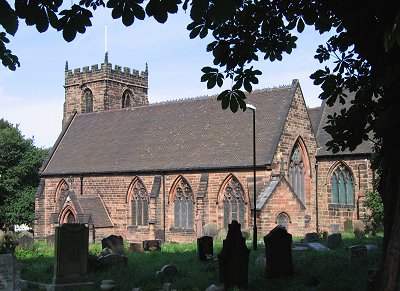
Listing: C14 with C15 tower but much restored in the
mid C19 by Edward Banks.
Also listed: base of churchyard cross (probably
C10/11); Bradburn Monument (1830s); Carter Headstone (Headstone to
Rev. John Carter, Catholic Priest, 1803. An unusual example of a
memorial to a Catholic priest in an Anglican graveyard, symbolic of
the religious toleration of Wolverhampton); gravestone to W of S
porch (probably late C13 or early C14); Hordern Tomb (chest tomb,
dated 1813); group of headstones to E of S porch, late C17 and early
C18); Jackson headstone (1680s).
Comment: for a full account, by the local historian,
the late Alex Chatwin, of this venerable church, click here. The church lies
almost on the edge of Wolverhampton and amidst fields.
This ancient foundation tells us of Bushbury's separate and
independent existence, from its days as an early agricultural
parish until almost the mid-20th century, when industry and
housing began creeping up from Wolverhampton in the south, until
almost every field was taken over. But in this part of
Bushbury there is still a lot of open space and views over
rolling fields. Just beyond the church is Bushbury Hall
and its farmyard outbuildings (all listed); and not far away is
Northicote Farm; all are redolent of an agricultural past.
The extensive churchyard contains many interesting memorials,
not all of them listed; and the church itself contains
many more.
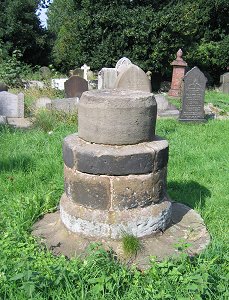 |
The base of the churchyard cross, probably 10th
or 11th century. There is another cross base
to the south of Wolverhampton at St. Batholomews,
Upper Penn; and an almost complete cross at St.
Peter's in the city centre. These, and the
collegiate churches at Wolverhampton and Tettenhall,
suggest that around the time of the conquest this
part of south Staffordshire was still regarded as
needing missionary work. |
| This gravestone, in a favoured
position close to the church beside the south
porch, is listed as "probably" late 13th century
or early 14th century. The remains of
carvings can be vaguely discerned on its
surface. |
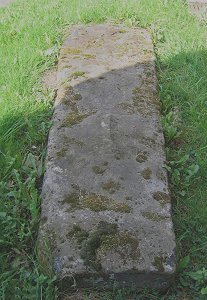 |
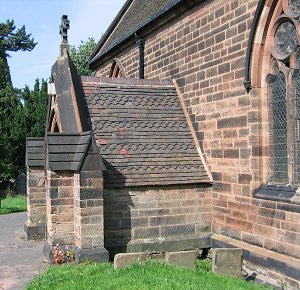 |
The three upright stones, in a favoured
position close to the church, are listed as
"group of headstones to E of S porch, late C17
and early C18". The dates on them, still
discernible, are within a few years of 1700. |
| The tombstone of the Revered John Carter,
who died in March 1803. Catholic priests
had to be buried somewhere so it is not all that
surprising to find one on a Church of England
churchyard. What is unusual is to find a
paean of praise on the stone. At the time
of his death Catholicism was tolerated in
Wolverhampton and was almost the norm in
Bushbury, with its local Catholic families and
associations with Charles II's flight from
Worcester.
It was only later in the 19th
century, with a huge influx of Irish workers,
that toleration broke down and religious riots
took place in Wolverhampton. |
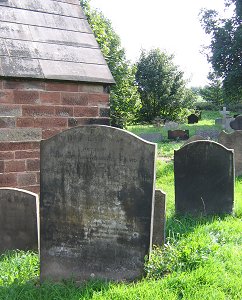 |
The inscription on the Carter stone reads:
"Beneath this stone repose the mortal remains of the Rev
John Carter, 26 years the Pastor of the Catholic
Congregation of Wolverhampton. He was a man of
uncommon talents, comprehensive, energetic, splendid.
In his principles independent, in his conduct unvarying,
ingenuous and kind. And though possessed of little,
with that little cheerfully content, and ever ready to
divide his pittance with the poor. Steadfast in his
religious belief, the duties of which he carefully impressed
on the minds of his flock, and the tenour of his life was a
comment on his doctrines. In the excellence of -?-
eloquence he was truly great [then five lines not yet
deciphered] May he rest in peace." The wording may
seem a little odd but it is not as odd as the layout which
has left justified lines of apparently random length.
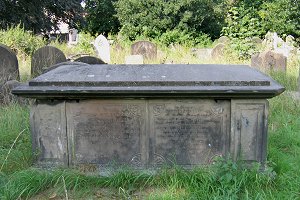 |
Chest tomb of some members of the Hordern
family, c.1813. There are other chest
tombs in the churchyard but they are not listed.
For Alex Chatwin's account of this family,
click here. |
| The Bradburn memorial, of the 1830s.
The memorial is signed "Jarratt, Wolverhampton". |
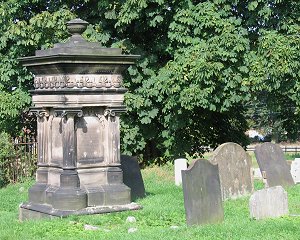 |
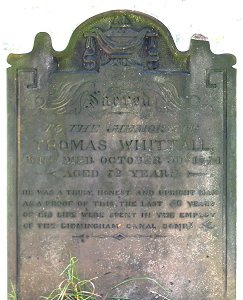 |
This gravestone, for Thomas Whittall, is not
listed but it is a fine piece of work and
contains the curious inscription: "He was
a truly honest and upright man. As a proof
of this, the last 56 years of his life were
spent in the employ of the Birmingham Canal Compy". |
The Jackson headstone of the 1680s, which is
listed, has not yet been identified and photographed.

|